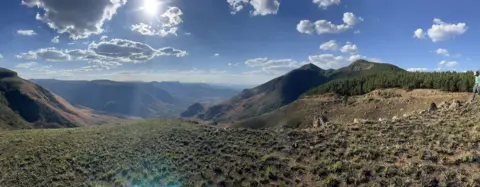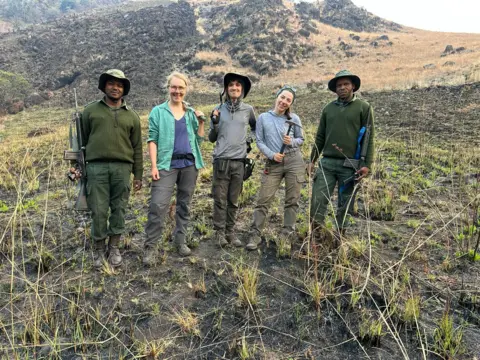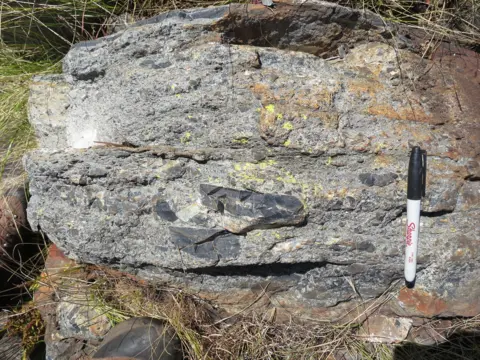S2 meteorite: What happened when a rock as big as London hit Earth?

 Getty Images
Getty ImagesA huge meteorite first discovered in 2014 caused a tsunami bigger than any in known human history and boiled the oceans, scientists have discovered.
The space rock, which was 200 times the size of the one that wiped out the dinosaurs, smashed into Earth when our planet was in its infancy three billion years ago.
Carrying sledge hammers, scientists hiked to the impact site in South Africa to chisel off chunks of rock to understand the crash.
The team also found evidence that massive asteroid impacts did not bring only destruction to Earth – they helped early life thrive.
“We know that after Earth first formed there was still a lot of debris flying around space that would be smashing into Earth,” says Prof Nadja Drabon from Harvard university, lead author of the new research.
“But now we have found that life was really resilient in the wake of some of these giant impacts, and that it actually bloomed and and thrived,” she says.
The meteorite S2 was much larger than the space rock we are most familiar with. The one that led to the dinosaurs’ extinction 66 million years ago was about 10km wide, or almost the height of Mount Everest.
But S2 was 40-60km wide and its mass was 50-200 times greater.
It struck when Earth was still in its early years and looked very different. It was a water world with just a few continents sticking out of the sea. Life was very simple – microorganisms composed of single cells.
 Nadja Drabon
Nadja DrabonThe impact site in Eastern Barberton Greenbelt is one of the oldest places on Earth with remnants of a meteorite crash.
Prof Drabon travelled there three times with her colleagues, driving as far as possible into the remote mountains before hiking the rest of the way with backpacks.
Rangers accompanied them with machine guns to protect them against wild animals like elephants or rhinos, or even poachers in the national park.
They were looking for spherule particles, or tiny fragments of rock, left behind by impact. Using sledge hammers, they collected hundreds of kilograms of rock and took them back to labs for analysis.
Prof Drabon stowed the most precious pieces in her luggage.
“I usually get stopped by security, but I give them a big spiel about how exciting the science is and then they get really bored and let me through,” she says.
 Nadja Drabon
Nadja DrabonThe team have now re-constructed just what the S2 meteorite did when it violently careened into Earth. It gouged out a 500km crater and pulverised rocks that ejected at incredibly fast speeds to form a cloud that circled around the globe.
“Imagine a rain cloud, but instead of water droplets coming down, it’s like molten rock droplets raining out of the sky,” says Prof Drabon.
A huge tsunami would have swept across the globe, ripped up the sea floor, and flooded coastlines.
The 2004 Indian Ocean tsunami would have paled in comparison, suggests Prof Drabon.
All that energy would have generated massive amounts of heat that boiled the oceans causing up to tens of metres of water to evaporate. It would also have increased air temperatures by up to 100C.
The skies would have turned black, choked with dust and particles. Without sunlight penetrating the darkness, simple life on land or in shallow water that relied on photosynthesis would have been wiped out.
 Nadja Drabon
Nadja DrabonThese impacts are similar to what geologists have found about other big meteorite impacts and what was suspected for S2.
But what Prof Drabon and her team found next was surprising. The rock evidence showed that the violent disturbances churned up nutrients like phosphorus and iron that fed simple organisms.
“Life was not only resilient, but actually bounced back really quickly and thrived,” she says.
“It’s like when you brush your teeth in the morning. It kills 99.9% of bacteria, but by the evening they’re all back, right?” she says.
The new findings suggest that the big impacts were like a giant fertiliser, sending essential ingredients for life like phosphorus around the globe.
The tsunami sweeping the planet would also have brought iron-rich water from the depths to the surface, giving early microbes extra energy.
The findings add to a growing view among scientists that early life was actually helped by the violent succession of rocks striking Earth in its early years, Prof Drabon says.
“It seems that life after the impact actually encountered really favourable conditions that allowed it to bloom,” she explains.
The findings are published in the scientific journal PNAS.
World News || Latest News || U.S. News
Source link




